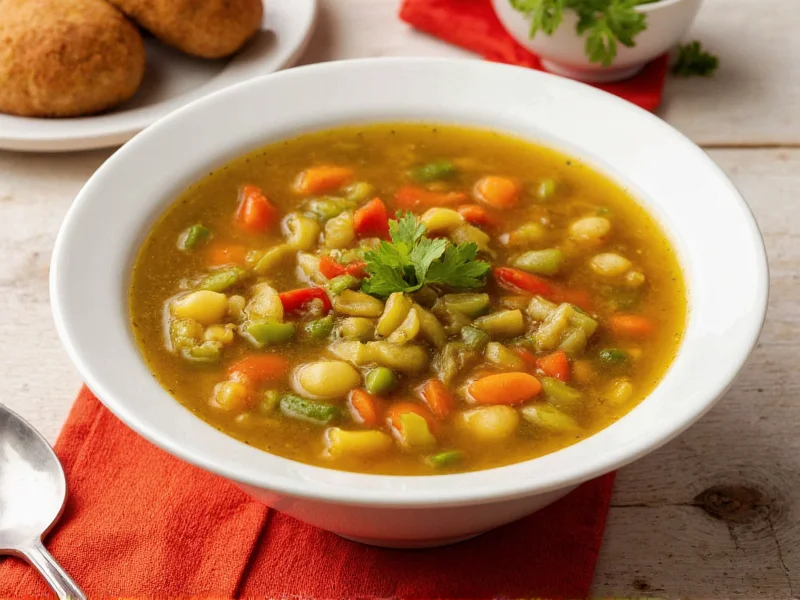Why Frozen Vegetables Make Perfect Soup Ingredients
Many home cooks mistakenly believe fresh vegetables always outperform frozen in soups. The truth is frozen vegetables often deliver superior results for hearty soups. Manufacturers typically freeze vegetables at peak ripeness, locking in nutrients that might degrade in 'fresh' produce during transportation. When making vegetable soup with frozen vegetables, you skip time-consuming prep work while ensuring consistent quality year-round.
Nutritional Benefits of Frozen Vegetable Soup
Frozen vegetables maintain comparable nutritional value to fresh counterparts. A 2023 Journal of Food Science study confirmed frozen peas, carrots, and corn retain 90-95% of vitamin C after six months. The blanching process before freezing preserves color and texture while inactivating enzymes that cause spoilage. When preparing vegetable soup with frozen vegetables, you actually gain advantages:
| Vegetable Type | Fresh Storage Loss (7 days) | Frozen Retention (6 months) |
|---|---|---|
| Green Beans | 45% vitamin C | 92% vitamin C |
| Broccoli | 58% vitamin C | 89% vitamin C |
| Carrots | 32% beta-carotene | 95% beta-carotene |
Best Frozen Vegetables for Soup
Not all frozen vegetables perform equally in soups. For optimal results in your vegetable soup with frozen vegetables, choose these varieties:
- Mixed vegetable blends - Typically contain carrots, peas, corn, and green beans that cook at similar rates
- Spinach and kale - Add during last 5 minutes to prevent overcooking
- Butternut squash cubes - Hold shape well during simmering
- Peas and corn - Maintain sweetness better than fresh when frozen
Avoid frozen tomatoes or zucchini for soup applications, as their high water content leads to mushiness. Instead, use canned tomatoes and fresh zucchini if desired.
Simple Vegetable Soup Recipe Using Frozen Vegetables
This 30-minute vegetable soup recipe with frozen vegetables serves four and requires minimal prep:
Ingredients
- 1 tablespoon olive oil
- 1 diced onion
- 2 minced garlic cloves
- 4 cups vegetable broth (low sodium)
- 2 cups frozen mixed vegetables
- 1 cup frozen spinach
- 1 (14oz) can diced tomatoes
- 1 teaspoon dried thyme
- Salt and pepper to taste
Step-by-Step Instructions
- Heat olive oil in large pot over medium heat. Sauté onions until translucent (5 minutes).
- Add garlic and cook for 1 minute until fragrant.
- Pour in vegetable broth and diced tomatoes (with juice). Bring to gentle simmer.
- Stir in frozen mixed vegetables and thyme. Do not thaw first.
- Cover and simmer for 15-20 minutes until vegetables reach desired tenderness.
- Add frozen spinach during last 5 minutes of cooking.
- Season with salt and pepper. Adjust broth consistency with water if needed.
Pro Tips for Flavorful Frozen Vegetable Soup
Transform your easy vegetable soup recipe with frozen vegetables from basic to brilliant with these chef-approved techniques:
- Layer flavors - Sauté aromatics (onion, celery, carrots) before adding broth
- Add acid at the end - A splash of lemon juice or vinegar brightens flavors
- Use herb stems - Toss parsley or thyme stems into broth while simmering
- Finish with umami - Stir in 1 tablespoon soy sauce or nutritional yeast
- Texture contrast - Reserve 1/2 cup frozen vegetables to add in last 5 minutes
Storage and Reheating Guidelines
Your vegetable soup with frozen vegetables maintains quality for up to 5 days in the refrigerator. For longer storage:
- Cool completely before transferring to airtight containers
- Leave 1-inch headspace for expansion if freezing
- Portion into single servings for quick reheating
- Thaw overnight in refrigerator before reheating
- Reheat gently on stove (not microwave) to preserve vegetable texture
Customizing Your Frozen Vegetable Soup
Make this healthy vegetable soup using frozen veggies your own with these variations:
- Protein boost - Add 1 cup cooked lentils or white beans during last 10 minutes
- Creamy version - Blend half the soup, then stir in 1/2 cup coconut milk
- Asian-inspired - Use ginger instead of thyme, add soy sauce and sesame oil
- Hearty minestrone - Include small pasta shapes and cannellini beans
Nutritional Profile
One serving (1.5 cups) of this vegetable soup recipe with frozen vegetables provides:
- 145 calories
- 6g fiber (24% daily value)
- 22g carbohydrates
- 5g protein
- Excellent source of vitamins A, C, and K
Frequently Asked Questions
Do I need to thaw frozen vegetables before adding to soup?
No, adding frozen vegetables directly to simmering broth yields better texture. Thawing first releases excess water that dilutes flavor. The gentle heat of simmering cooks frozen vegetables evenly without making them mushy.
Which frozen vegetables work best in chunky vegetable soup?
Carrots, green beans, and corn maintain their shape well in soups. Peas and spinach work best but should be added during the last 5 minutes of cooking. Avoid frozen zucchini or tomatoes as they become too soft.
How can I make frozen vegetable soup taste less 'frozen'?
Boost freshness with finishing touches: add fresh herbs just before serving, a squeeze of lemon juice, or a drizzle of good quality olive oil. Sautéing aromatics like onions and garlic before adding broth creates deeper flavor foundations that mask any 'frozen' taste.
Can I use frozen vegetable soup as a base for other recipes?
Absolutely. This versatile vegetable soup with frozen vegetables makes an excellent base for risotto, grain bowls, or as cooking liquid for quinoa. You can also puree it for a quick sauce base or freeze portions for future recipes requiring vegetable stock.











 浙公网安备
33010002000092号
浙公网安备
33010002000092号 浙B2-20120091-4
浙B2-20120091-4